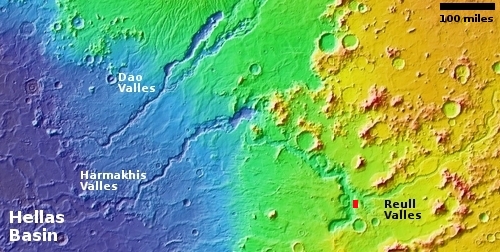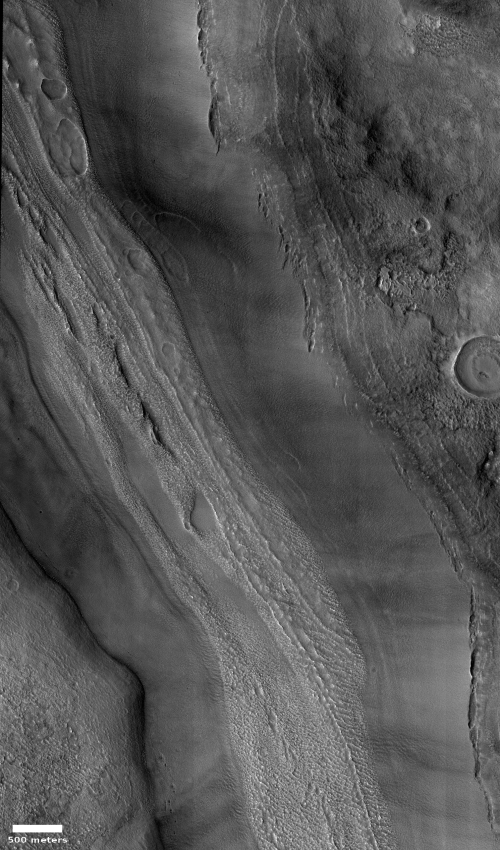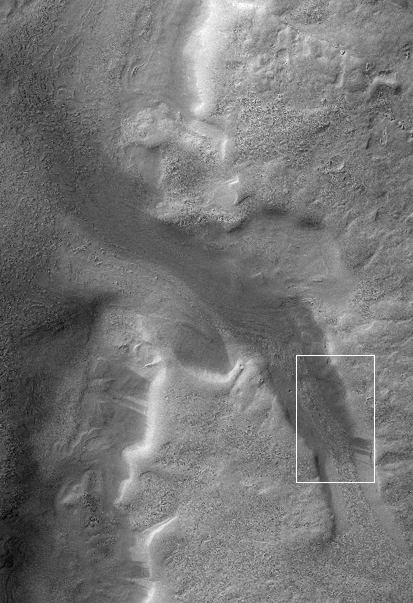A massive Martian glacier that looks just like a glacier on Earth
If you ever had any doubt about the existence of glaciers on Mars, today’s cool image should ease those doubts. The photo to the right, taken on August 27, 2020 by the high resolution camera on Mars Reconnaissance Orbiter (MRO) and rotated, cropped, and reduced to post here, shows many features that are appear identical to features found on typical massive glaciers on Earth.
Downhill is to the northwest. The many parallel grooves or fractures running along the length of the glacier resemble what are seen in many similar Earth glaciers. Some of these fractures are caused by the glaciers slow drift downward, with different sections moving at slightly different rates, thus causing a separation along the flow. Hence the parallel fractures.
These fractures also show evidence of some erosion. Because these Martian glaciers are no longer getting more snowfall, they are no longer growing. However, if the thin layer of dust and debris that protects the ice gets blown off or removed by motion, the ice is exposed and can then sublimate into gas so that the glacier erodes.
On the flow’s edges the darker parallel lines also resemble features seen on Earth, showing the exposed layers of the glacier’s past levels. The same thing can be seen on either side of the canyon’s walls.
The wide smooth section near the center of the parallel lines could very well be an impact crater that landed on this glacier sometime in the far past, and has since been distorted in shape as the glacier flowed downward.
If you still have doubts, the context image below, taken by MRO’s wide angle context camera, should help further allay those doubts.
I have rotated, cropped, and reduced the image to post it here. The white rectangle indicates the area covered by the first photo above.
Not only does this glacial flow cut downward into a much larger flow running from south to north, it actually cuts into it, almost like a swiftly flowing tributary of water when it runs into a slow-moving larger river. You can even see evidence of the two flows slowly intermingling as they move to the right into the middle of that larger flow.
The wide photo also suggests that the plateaus above are all ice covered, as at the start of this canyon it appears that the plateau’s top layer is providing the material for the glacial flow.
I do not know why the flow changes brightness as it moves downward. That requires a level of geological knowledge beyond my pay grade. My first guess is that we are seeing more dust and debris on the lower parts of the glacier, blown into the canyon by wind and then trapped there. The color strip for the image appears to reinforce this supposition, in that the blue areas (which suggest either water or rougher terrain) are on the canyon walls and low areas next to those walls. Everywhere else the colors are bright red or orange, suggesting the ice is covered with debris. Even so, my theory is likely wrong, as my knowledge of this geology is somewhat limited.
The overview map below provides an even wider context. It shows that this glacier, indicated by the red box, is flowing into Reull Valles, one of several meandering canyons that flow down into Hellas Basin, the basement of Mars.

If you search Behind the Black for “Reull,” you will see numerous cool images showing many other glacial features in this 600-mile-long meandering canyon. The canyon has many features suggesting glacial activity, but scientists have also supposed flowing water was involved in its formation as well.
To me, the best piece of evidence that favors a mostly glacial process is the first image I ever posted of this valley, showing the valley floor much farther upstream. What struck me most about that photo was how little evidence there was in the center of the canyon of any flow direction.
What we have is a complex pattern of sharp curving ridges with depressions meandering in all directions. There is absolutely no indication that a river once flowed across this surface from the east to the west. None.
Other images of Reull Vallis do show [a downstream] flow pattern. At this location, however, where the valley floor appears to be particularly wide, that flow pattern vanishes and is replaced by this helter-skelter terrain, illustrating what the planetary geologists readily admit: “The morphology of Reull Vallis suggests it had a long and complex history, including subsurface and surface movement of fluids followed by extensive modification by mass wasting.”
The lack of obvious flow pattern now suggests to me a much slower flow than you find with liquid water.
That last quote comes from a 2014 Mars Express press release, when it was widely believed that liquid water must have formed these meandering canyons. In the subsequent six years the evidence has continued to pile up to favor glacial flows, not liquid water, as the process that created these canyons. While nothing is proven yet, the evidence at this time is leaning in that direction.
On Christmas Eve 1968 three Americans became the first humans to visit another world. What they did to celebrate was unexpected and profound, and will be remembered throughout all human history. Genesis: the Story of Apollo 8, Robert Zimmerman's classic history of humanity's first journey to another world, tells that story, and it is now available as both an ebook and an audiobook, both with a foreword by Valerie Anders and a new introduction by Robert Zimmerman.
The print edition can be purchased at Amazon or from any other book seller. If you want an autographed copy the price is $60 for the hardback and $45 for the paperback, plus $8 shipping for each. Go here for purchasing details. The ebook is available everywhere for $5.99 (before discount) at amazon, or direct from my ebook publisher, ebookit. If you buy it from ebookit you don't support the big tech companies and the author gets a bigger cut much sooner.
The audiobook is also available at all these vendors, and is also free with a 30-day trial membership to Audible.
"Not simply about one mission, [Genesis] is also the history of America's quest for the moon... Zimmerman has done a masterful job of tying disparate events together into a solid account of one of America's greatest human triumphs."--San Antonio Express-News
If you ever had any doubt about the existence of glaciers on Mars, today’s cool image should ease those doubts. The photo to the right, taken on August 27, 2020 by the high resolution camera on Mars Reconnaissance Orbiter (MRO) and rotated, cropped, and reduced to post here, shows many features that are appear identical to features found on typical massive glaciers on Earth.
Downhill is to the northwest. The many parallel grooves or fractures running along the length of the glacier resemble what are seen in many similar Earth glaciers. Some of these fractures are caused by the glaciers slow drift downward, with different sections moving at slightly different rates, thus causing a separation along the flow. Hence the parallel fractures.
These fractures also show evidence of some erosion. Because these Martian glaciers are no longer getting more snowfall, they are no longer growing. However, if the thin layer of dust and debris that protects the ice gets blown off or removed by motion, the ice is exposed and can then sublimate into gas so that the glacier erodes.
On the flow’s edges the darker parallel lines also resemble features seen on Earth, showing the exposed layers of the glacier’s past levels. The same thing can be seen on either side of the canyon’s walls.
The wide smooth section near the center of the parallel lines could very well be an impact crater that landed on this glacier sometime in the far past, and has since been distorted in shape as the glacier flowed downward.
If you still have doubts, the context image below, taken by MRO’s wide angle context camera, should help further allay those doubts.
I have rotated, cropped, and reduced the image to post it here. The white rectangle indicates the area covered by the first photo above.
Not only does this glacial flow cut downward into a much larger flow running from south to north, it actually cuts into it, almost like a swiftly flowing tributary of water when it runs into a slow-moving larger river. You can even see evidence of the two flows slowly intermingling as they move to the right into the middle of that larger flow.
The wide photo also suggests that the plateaus above are all ice covered, as at the start of this canyon it appears that the plateau’s top layer is providing the material for the glacial flow.
I do not know why the flow changes brightness as it moves downward. That requires a level of geological knowledge beyond my pay grade. My first guess is that we are seeing more dust and debris on the lower parts of the glacier, blown into the canyon by wind and then trapped there. The color strip for the image appears to reinforce this supposition, in that the blue areas (which suggest either water or rougher terrain) are on the canyon walls and low areas next to those walls. Everywhere else the colors are bright red or orange, suggesting the ice is covered with debris. Even so, my theory is likely wrong, as my knowledge of this geology is somewhat limited.
The overview map below provides an even wider context. It shows that this glacier, indicated by the red box, is flowing into Reull Valles, one of several meandering canyons that flow down into Hellas Basin, the basement of Mars.

If you search Behind the Black for “Reull,” you will see numerous cool images showing many other glacial features in this 600-mile-long meandering canyon. The canyon has many features suggesting glacial activity, but scientists have also supposed flowing water was involved in its formation as well.
To me, the best piece of evidence that favors a mostly glacial process is the first image I ever posted of this valley, showing the valley floor much farther upstream. What struck me most about that photo was how little evidence there was in the center of the canyon of any flow direction.
What we have is a complex pattern of sharp curving ridges with depressions meandering in all directions. There is absolutely no indication that a river once flowed across this surface from the east to the west. None.
Other images of Reull Vallis do show [a downstream] flow pattern. At this location, however, where the valley floor appears to be particularly wide, that flow pattern vanishes and is replaced by this helter-skelter terrain, illustrating what the planetary geologists readily admit: “The morphology of Reull Vallis suggests it had a long and complex history, including subsurface and surface movement of fluids followed by extensive modification by mass wasting.”
The lack of obvious flow pattern now suggests to me a much slower flow than you find with liquid water.
That last quote comes from a 2014 Mars Express press release, when it was widely believed that liquid water must have formed these meandering canyons. In the subsequent six years the evidence has continued to pile up to favor glacial flows, not liquid water, as the process that created these canyons. While nothing is proven yet, the evidence at this time is leaning in that direction.
On Christmas Eve 1968 three Americans became the first humans to visit another world. What they did to celebrate was unexpected and profound, and will be remembered throughout all human history. Genesis: the Story of Apollo 8, Robert Zimmerman's classic history of humanity's first journey to another world, tells that story, and it is now available as both an ebook and an audiobook, both with a foreword by Valerie Anders and a new introduction by Robert Zimmerman.
The print edition can be purchased at Amazon or from any other book seller. If you want an autographed copy the price is $60 for the hardback and $45 for the paperback, plus $8 shipping for each. Go here for purchasing details. The ebook is available everywhere for $5.99 (before discount) at amazon, or direct from my ebook publisher, ebookit. If you buy it from ebookit you don't support the big tech companies and the author gets a bigger cut much sooner.
The audiobook is also available at all these vendors, and is also free with a 30-day trial membership to Audible.
"Not simply about one mission, [Genesis] is also the history of America's quest for the moon... Zimmerman has done a masterful job of tying disparate events together into a solid account of one of America's greatest human triumphs."--San Antonio Express-News




I’m wondering how glacier development is changed by the much lower surface gravity of Mars. At the very least glacier flow must be much slower.